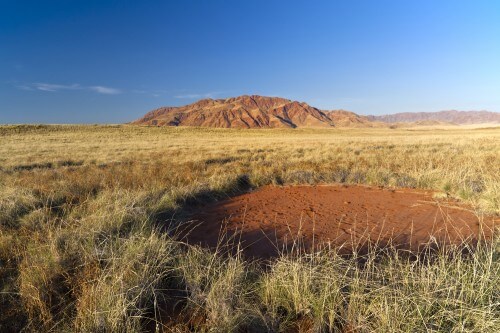New research demystifies the grass circles that adorn Namibia where the vegetation surrounds a dead area

Those who travel in the south of Namibia will see the thousands of mysterious circles in the sandy plains, which are formed when the grass grows in a circular shape and inside the circle there is no vegetation.
The circles are "decorated" mainly by two species of grasses Stipagrostis ciliata and S. giessii. The diameter of the circles is from half to about 12 meters, and there are places where the circles cover large areas, when the grass that grows in the circles is taller and more vital than around.
The circles appear and disappear in a cycle that is not clear and in an irregular distribution. The lifespan of a circuit can reach up to about 60 years. Following the appearance of the circles, tiny hills are formed in their center and the ground is more moist below, possibly due to a lower utilization of the moisture by the grasses.
Previously when I referred to the circles of grass that decorate the plains of Namibia, I brought different attempts to explain their formation. They "blamed" gas emissions, soil salinity, "unknown" factors and more. The most accepted explanation was that the circles are "the result of the activity of termites that eat the roots of the grass and since they work from the center outwards, the circles are formed." Like other explanations, the termite assumption has not been verified.
Recently published in PLoS ONE
A study that tries again to explain the circles. According to the two researchers - - Nicole Barger and Michael Cramer Nichole N. Barger Michael D. Cramer, despite studies and tests there is no clear explanation for the phenomenon and yet they try to establish that the circles are the result of: "Self-Organizing Spatial Vegetation Patterning" .”
The researchers continue and claim that: "Fortunately, the explanation is simpler than it sounds", in dry habitats like the one in Namibia, there is a constant competition for resources and especially for water. The "barren" circles are created because of competition that takes place below the surface of the ground, when individuals (plants) strengthen their grip on the underground resources. Neighboring individuals deteriorate, retreat and finally die, thus creating empty spaces.
In other words: an individual who "wins" water condemns his neighbor to death by dehydration, and where the neighbor (who died) grew, an empty spot was created. This is how the researchers explain the connection and the formation of fairy circles.
The researchers continue and claim that: instead of "killing all the competitors", the central patch that is formed gives the plants at its edge an advantage since it stores moisture and nutrients. According to the researchers, the resource center causes the creation of a "neighborhood" system between plants that get along in a circle. The formation of circles allows for improved absorption of moisture, which allows larger, healthier and stronger grasses... in circles.
The study, which was conducted through soil tests, aerial photographs and with the help of computer models, showed that by considering environmental data such as precipitation, temperature and the amount of plants in the field, it is possible to "predict" the formation of fairy circles.
After all this, the researchers leave room for doubt and other factors in the formation of the circles, such as the possibility that termites "guard" the circles from the intrusion of weeds of other species. According to the researchers, termites of a certain species (P. allocerus) contribute to the circles by eating plants that grow inside them - indeed there are circles in the center of which dead grass stalks are found. A sign of termite activity.
Although in the new study the researchers rely on the theory of competition for resources between the grasses to explain the creation of the fairy circles, they go on to say that a set of complex factors, including the reproductive form of plants, the activity of animals (termites) and other factors, one of which is the competition for resources creates the circles
Despite the new study, the researchers add words of skepticism and say that: "Until time (and further studies) show that "competition for resources" is the cause of fairy circles, the circles will continue to be a mystery."
And as I wrote before: until it is explained otherwise, the circles were created by fairies and as such are a source of attraction for "strange and supernatural explanations", for amateur researchers, wizards and sorcerers and the main thing.... for tourists

4 תגובות
Asaf
How can the rotation of the earth cause this?
https://en.m.wikipedia.org/wiki/Fairy_ring
Maybe the rotation of the earth, maybe the activities of germs, I wonder if this happens in other places in the world.